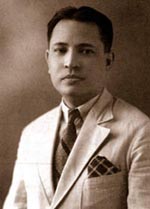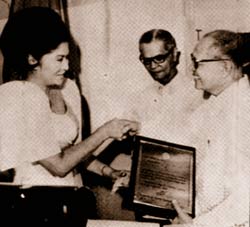BOOK
REVIEW
Reclaiming
Ka Amado
By
emphasizing the significance of Amado V. Hernandez in the historical scheme as a
socially committed writer of the highest order, Suri at Sipat: Araling Ka
Amado reclaims—with finality—his legacy from the clutches of posthumous
cooptation, and clarifies that his proper place is—as it invariably was during
his lifetime—on the side of the struggling masses.
 BY
ALEXANDER MARTIN REMOLLINO BY
ALEXANDER MARTIN REMOLLINO
Bulatlat.com
Exactly
six months after the celebration of the centennial birth anniversary of Amado V.
Hernandez—activist/labor leader, poet, journalist, dramatist/fictionist—a
book on the man and his writings was launched at the University of the
Philippines in Diliman, Quezon City.
Edited
by leading art critic and historian Alice G. Guillermo and Ateneo de Manila
University professor Charlie Samuya Veric, Suri at Sipat: Araling Ka Amado
(Scrutiny and Sighting: Studies on Ka Amado) is published by the Amado V.
Hernandez Resource Center (AVHRC) and the National Commission on Culture and the
Arts. It puts together essays from noted scholars of Hernandez’s life and
works: Rosario Torres-Yu, Dr. Epifanio San Juan, Jr., Dr. Bienvenido Lumbera,
Gelacio and Ramon Guillermo, Monico Atienza, Enrique Francia, and Veric.
In
its foreword, the AVHRC states: “Ang mga akdang tinipon sa aklat ay hindi
lamang bunga ng kumperensya na naglunsad sa pagdiriwang ng sentenaryo na ginanap
sa Cultural Center of the Philippines noong Setyembre 13, 2002. Pinili sila
upang ipakita ang wastong pagtanaw, ang wastong pagsipat, sa katauhan at ambag
ni Ka Amado sa panitikan at lipunan (The writings collected are not just
products of the conference that initiated the centennial celebration at the
Cultural Center of the Philippines on Sept. 13, 2002. They were chosen to show
the correct way of looking at and analyzing Ka Amado and his contributions to
literature and society.)”
The
book is divided into five chapters corresponding to the different aspects of
Hernandez’s life and works: Manunulat sa Kanyang Lipunan (Writer in his
Society), Sangandaan ng
Tradisyon at Pagbabago (Crossroads of Tradition and Change), Pulitika ng
Pagkilala kay Ka Amado (Politics of Assessing Ka Amado), Ka Amado at ang
Mapagpalayang Kilusan (Ka Amado and the Liberation Movement), and Manunulat
sa Kanyang Daigdig (Writer in His World).
 Unifying
thread Unifying
thread
But
though the essays in this book tackle various aspects of Hernandez’s life and
works, they are bound by a common thread. At some point each of the essays
stresses the significance of Hernandez as a writer who stood unequivocally for
the Filipino people’s liberation from national and social oppression.
The
emphasis on Hernandez’s historical role as a dedicated people’s writer—as
one who depicted almost graphically in his writings the sufferings of common
Filipinos, particularly workers and peasants, in the hands of the moneyed
classes and their imperialist masters, and discoursed on the importance of
struggle for revolutionary change—is of no small importance.
As
Lumbera points out in his essay “Si A.V. Hernandez Bilang Pambansang
Artista (A.V. Hernandez as National Artist),” while Hernandez undoubtedly
deserves to be a National Artist for Literature—which the Marcos government
named him as in 1973—the award was given in an attempt to coopt his legacy.
“Wari’y tunay na pagtangkilik ang ginawa ng Bagong Lipunan sa makata at
lider manggagawa nang iluklok ito bilang isang Pambansang Artista (It seemed
that the New Society truly recognized the poet and labor leader when it named
him as National Artist),” Lumbera writes. “Sa katunayan, inagaw si
Hernandez sa kilusang mapagpalaya at sa panahong umiiral pa ang Batas Militar sa
bansa,kinulong siya sa isang bilangguang kristal upang hindi siya pakinabangan
bilang huwarang rebolusyonaryong manlilikha. (In fact, Hernandez was seized
from the liberation movement and at a time when martial law was still in place,
he was placed in a crystal cage to prevent him from being emulated as a
revolutionary artist.)”
Not
only did Hernandez write about the need to fight for revolutionary change—he
was also a prominent part of it as anti-imperialist activist, labor leader, and
civil libertarian.
Hernandez
had been dead for three years when he was named National Artist for Literature.
The award was given a year after the declaration of martial law.
During
martial law, many of the writers who advanced the causes Hernandez fought
for—among them Liliosa Hilao, Jose Maria Sison, Ma. Lorena Barros, Bonifacio
Ilagan, Jose F. Lacaba, Satur Ocampo, Luis Teodoro, and Bienvenido Lumbera—were
incarcerated. A number of them — like Hilao, Sison, Ilagan, Lacaba, and Ocampo—were
heavily tortured by their military custodians, and Hilao would eventually become
the first political detainee to die in the hands of the dictatorship. (Barros
escaped from prison and eventually joined the armed struggle, where she lost her
life in an encounter.)
Others,
like Romulo Sandoval and Antonio Zumel (now both deceased), eluded arrest but
were forever on the run at the same time that they valiantly carried out various
forms of resistance work.
If
Hernandez had been alive at the height of martial law, he would surely have met
the same fate as that of the writers who were punished or pursued by the fascist
Marcos regime for taking the side of the oppressed against the oppressors.
 In
naming him National Artist for Literature, the Marcos government sought to
project itself as a regime that represented the progressive aspirations of the
people—a subtle way of sanitizing itself. In
naming him National Artist for Literature, the Marcos government sought to
project itself as a regime that represented the progressive aspirations of the
people—a subtle way of sanitizing itself.
Sanitization
was part of the Marcos dictatorship’s arsenal: it tried to pose as a radical
regime by paying lip service to nationalism even as it rabidly followed the U.S.
agenda, employing the rhetoric of railing against the “oligarchy” even as it
had its own set of elite cronies, and mouthing such militant-sounding slogans as
“democratic revolution from the center.” As Alice G. Guillermo points out in
the introduction, “Sinikap ni Marcos na ipaloob sa ideolohikal na sistema
ng kanyang diktadura ang kahalagahang makabayan upang makamit niya ang suporta
ng buong sambayanan sa ilalim ng kanyang bandilang ‘Isang Bansa Isang Diwa.’
(Marcos tried hard to incorporate patriotic values into his dictatorship’s
ideological apparatus in order to gain the support of the entire people under
his banner ‘One Nation One Spirit.’)”
That
the Marcos government did not really take seriously the social causes Hernandez
espoused in his writings, even as it paid lip service to his practice of
“committed art,” is made all the more evident in the fact that he and Jose
Garcia Villa, as noted by Lumbera, were named National Artists for Literature in
the same year. Villa was an unabashed exponent of a literature that steers clear
of political questions in the midst of neocolonial oppression and social
injustice.
The
Marcos government considered Hernandez a “safe” figure because when martial
law was imposed, he could no longer refute its pretensions to progressive
politics.
 A
people’s writer to the end A
people’s writer to the end
But
as Gelacio Guillermo points out, Hernandez’s last poem, “Enrique Sta.
Brigida, Paghahatid sa Imortalidad (Enrique Sta. Brigida, To
Immortality)”—written in 1970 at the onset of the First Quarter Storm—is a
tribute to seven student activists slain in the “Battle of Mendiola” and an
open call for revolutionary armed struggle. He quotes from the poem: “…isang
higanteng nagbabalikwas na paa’y/Central Luzon at ang ulo’y/Sierra Madre,
nagsisigaw sa sansinukob:/Makibaka, huwag matakot,/Hanggang sa ang bulok na
sosyedad ay bumagsak at/Madurog! (…a giant restive, whose feet/Are Central
Luzon and whose head/Is the Sierra Madre, shouting to the universe:/Fight, fear
not/Until the rotten society/Is felled and crushed!)”
Yu
and San Juan both tackle the politics of Hernandez and how it figured in his
writings. They also point out that though Hernandez received several awards from
the neocolonial establishment, the totality of his life and works do not give
any reason to suspect the man.
Ramon
Guillermo reviews the three versions of the Hernandez poem “Bayani
(Hero)” which were written under three different historical conditions.
Francia, meanwhile, compares Hernandez to Praemoedya Ananta Toer, a progressive
Indonesian writer.
In
his piece, “Kung Ano ang Nakataya sa Pagsasalin kay Ka Amado (What is
at Stake in Translating Ka Amado),” Veric discusses Cirilo F. Bautista’s
translation into English of selected poems by Hernandez and its political
implications.
Of
the writers whose works appear in the book, it is Atienza who touches on the
more human side of Hernandez. His piece, “Si Mang Amado, Si Ka Joma atbp:
Huntahang Samu’t Sari (Mang Amado, Ka Joma, et al: Various Tete-a-tetes),”
contains a good number of humorous and inspiring anecdotes on Hernandez. But the
anecdotes Atienza chose to cite still fit neatly into the over-all context of
Hernandez’s work as writer and activist. These are stories of incidents
in the course of Hernandez’s interaction with fellow writers and activists.
By
emphasizing the significance of Amado V. Hernandez in the historical scheme as a
socially committed writer of the highest order, Suri at Sipat: Araling Ka
Amado reclaims—with finality—his legacy from the clutches of posthumous
cooptation, and clarifies that his proper place is—as it invariably was during
his lifetime—on the side of the struggling masses. Bulatlat.com
Back
to top
We
want to know what you think of this article.
|

